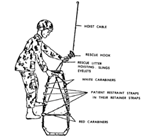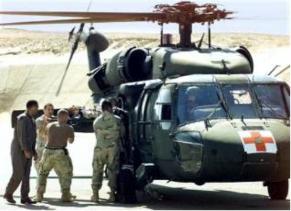|
CORRESPONDENCE
COURSE
U.S. ARMY MEDICAL DEPARTMENT CENTER AND SCHOOL
SUBCOURSE MD0001 EDITION 200
EVACUATION IN THE FIELD
Other subcourses in the Health Care Specialist series provide
instruction on treating various wounds and injuries. Many times, the
last step given in the treatment instructions is to evacuate the
casualty to a medical treatment facility.
This subcourse describes procedures for evacuating casualties to a
medical treatment facility or to a point where they can be picked up
by an evacuation vehicle and transported to a medical treatment
facility.
-----------------
Length: 190 Pages
Estimated Hours to Complete: 12
Format: PDF file
Size: 4.9 MB
-------------------
Anyone may take this course. However, to receive credit hours, you
must be officially enrolled and complete an examination furnished by
the Nonresident Instruction Branch at Fort Sam Houston, Texas.
Enrollment is normally limited to Department of Defense personnel.
Others may apply for enrollment, but acceptance is not guaranteed.

Evacuation in the Field
Distance Learning
Course
190 Pages
Est. 12 Hours
4.9 MB pdf file
Download Now |
|

TABLE OF CONTENTS
INTRODUCTION
1 TRIAGE AND
EVACUATION FLOW
Section I.
Triage Procedures
Section II.
Evacuation Flow
Exercises
2 MANUAL
CARRIES
Section I.
General
Section II.
One-Man Carries
Section III.
Two-Man Carries
Exercises
3 LITTERS AND
LITTER CARRIES
Section I.
Litters
Section II.
Dressing a Litter
Section III.
Placing a Casualty on a Litter
Section IV.
Litter Carries
Exercise
4 GROUND
EVACUATION VEHICLES
Section I.
Ground Ambulances
Section II.
Nonmedical Military Vehicles
Exercises
5 AEROMEDICAL
EVACUATION
Section I.
Air Ambulances
Section II.
High Performance Hoist Operations
Section III.
Aeromedical Evacuation Request
Section IV.
Preparing a Landing Site
Exercises
6 REMOVING
CASUALTIES FROM TACTICAL VEHICLES
Exercises
----------------------------------------------
LESSON 1
TRIAGE AND EVACUATION FLOW
Section I. TRIAGE PROCEDURES
1-1. INTEGRATED BATTLEFIELD
Modern weapons are far more deadly and accurate than
those used in past conflicts. The AirLand Battle doctrine, which is
the Army's basic operational concept, involves preparing for an
integrated battlefield in which conventional air and land weapons,
nuclear weapons, biological weapons, chemical weapons, and directed
energy (laser) weapons may be used. Military commanders will rely upon
medical resources to treat, evacuate, and (when possible) return
soldiers to duty. In the initial phases of battle, the soldiers who
are evacuated, treated, and returned to duty may provide the tactical
commander with his only source of trained combat replacements.
1-2. TRIAGE
Triage means sorting. Triage is used to determine the
sequence in which casualties are to be treated in order to maximize
the number of survivors and to return to duty those soldiers with
minor wounds. Triage is also used to determine the sequence in which
casualties are to be evacuated. Triage is a continuous process that is
performed at each medical treatment facility (MTF) through which the
casualties pass. The goal of successful triage is to do the most good
for the most people. Triage is usually performed by the most senior
medical person available.
1-3. TRIAGE FOR TREATMENT (NONCHEMICAL ENVIRONMENT)
When a medic (or any other person) has more than one
casualty, he must decide which casualty to treat first. Some injuries
require immediate treatment if the casualty is to live while others
can go for a fairly long time without treatment before the casualty's
condition deteriorates significantly. When chemical agents are not
being used, casualties are triaged as being immediate, delayed,
minimal, or expectant and are treated in that order. Triage assures
that treatment is directed first toward casualties who have the best
chance to survive based upon available medical personnel and supplies.
Triage determines the order of treatment, not whether or not treatment
is given.
a. Immediate. A casualty in
the immediate category requires immediate care if he is to survive.
Once a casualty in the immediate category has been treated and the
life-threatening or limb-threatening condition controlled (airway
obstruction expelled, tourniquet applied, and so forth), the treatment
of the casualty's other non-immediate injuries are delayed until the
life/limb-threatening conditions of other casualties have been
treated. Procedures used are short duration and use only essential
medical resources. Examples of casualties in this category include
casualties with:
(1) An obstruction of the airway or respiratory
distress.
NOTE: A casualty with cardiopulmonary
failure in a battlefield situation is categorized
as expectant.
(2) Bilateral femur fractures.
(3) Massive external bleeding.
(4) Shock.
(5) Second and/or third degree burns of the face,
neck, hands, feet, perineum, and/or genitalia, but with less than 85
percent of the body's surface burned.
NOTE: A casualty with second or third
degree burns of the face or neck will usually be in shock and have
respiratory distress.
(6) Penetrating chest injuries.
b. Delayed. A
casualty in the delayed category has less risk of death or loss of
limb if treatment is delayed than a casualty in the immediate
category. Examples of casualties in this category include casualties
with:
(1) Extensive soft tissue wounds requiring
debridement.
(2) Maxillofacial wounds without airway compromise.
(3) Vascular injuries with adequate distal
circulation.
(4) An a vascular limb (damaged blood vessels in the
limb resulting in the arm or leg having a poor blood supply or no
blood supply).
(5) Second and/or third degree burns on 20 to 85
percent of the casualty's body surface, but not including the face,
neck, hands, feet, perineum, or genitalia.
(6) Other open wounds, including an open head wound.
(7) Fractures requiring operative manipulation,
debridement, and fixation.
c. Minimal. Casualties in
the minimal category generally do not require evacuation to a MTF.
These casualties can usually be treated with self-aid (casualty treats
himself) or buddy-aid (casualty treated by a nonmedical soldier, such
as a combat lifesaver). Treatment by the medic, if needed, can usually
be performed quickly. Some of these casualties can be returned to
duty. Others can be used by the medic to assist in providing care,
defending the immediate area, or evacuating casualties. Examples of
casualties in this category include casualties with:
(1) Soft tissue wounds without profuse bleeding
(minor lacerations and contusions).
(2) Upper extremity fractures, fingers,
dislocations, and sprains.
(3) Second and/or third degree burns under 20
percent of the casualty's body surface and not involving the face,
neck, hands, feet, perineum, or genitalia.
(4) Combat stress (battle fatigue).
d. Expectant.
Casualties in the expectant category have life-threatening conditions
that are beyond the capability of the medic to treat and only
complicated and prolonged treatment offers any hope of improving life
expectancy. This category is used only if resources are limited.
Examples of casualties in this category include casualties with:
(1) Massive head injuries with signs of impending
death (unresponsive with penetrating head wounds).
(2) Burns, mostly third degree, covering more than
85 percent of the body's surface area.
(3) Mutilating wounds involving multiple structures.
(4) Agonal respirations (ineffective gasping breaths).
From Evacuation
in the Field
|


